Occupy Scandinavia's Long Winter
Occupy Scandinavia’s Long Winter
by Lauren Kirchner
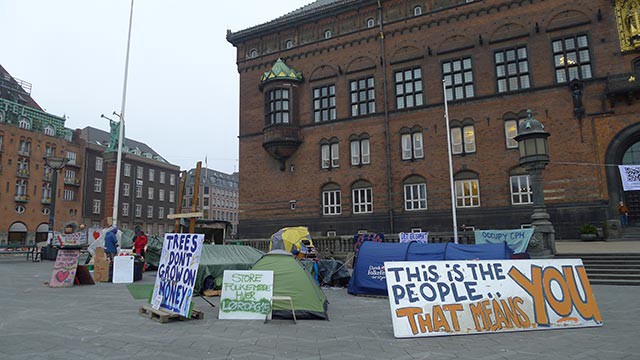
By all accounts, Scandinavia is one of the most prosperous, peaceful and income-equal places to live in the world. Sweden, Finland, Norway and Denmark hold four of the top five spots in the World Democracy Index (the U.S. ranks 15th). The Scandinavian countries are all the way at the top of OECD’s ranking of the happiest countries in the world (the U.S. is 19th), and they’re all the way at the bottom of the CIA’s ranking of countries by income inequality (the U.S. is 40th out of 140).
But when, on October 15, rallies inspired by the Occupy Wall Street movement were held around the world, protesters in these same countries joined in. Everywhere I went in Scandinavia last fall, Occupy sympathizers were setting up camp for the winter. And of course, not only were these some of the most utopian places you can visit — they also happen to be some of the coldest. As I watched the most climactic moments of the Zuccotti Park occupation, 4,000 miles from home and cursing my timing, I wondered: What did these protesters have to complain about? And didn’t they notice it was getting cold out?
I was in Sweden on October 15, when several hundred people gathered in Stockholm’s Sergels torg, a public plaza with a Union Square vibe. Afterwards the protesters all voted on the location for a permanent camp. They chose a grassy triangle of land in the shadow of the Kulturhuset building, the city’s main cultural center.
When I visited the camp, a dozen or so people were set up in a group of small camping tents. One tent was set up with paint, brushes and canvases inside, and another tent was designated for generator-powered cooking. The camp had also just received a military tent from an anonymous donor, which was a huge boon; it was a tent designed with the famously long, dark, and icy Scandinavian winters in mind, making the group’s plan to stay until spring much more realistic. I saw a big sign that said “Vi är inte en handelsvara som ligger i politikers och bankmäns händer,” which means, “We are not a commodity to be held in politicians’ and bankers’ hands.” Another was spray-painted (in English), “Some people are so poor, all they have is money.”
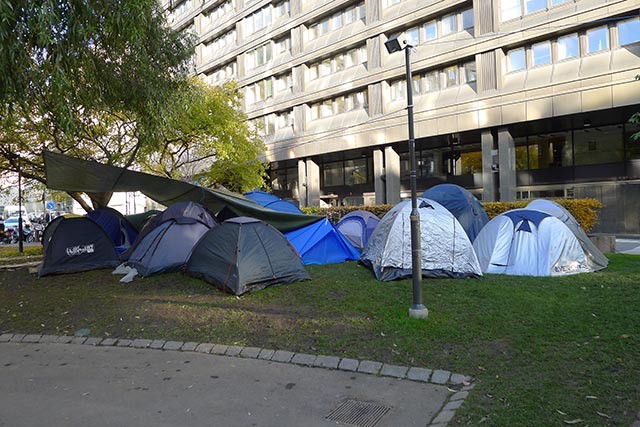
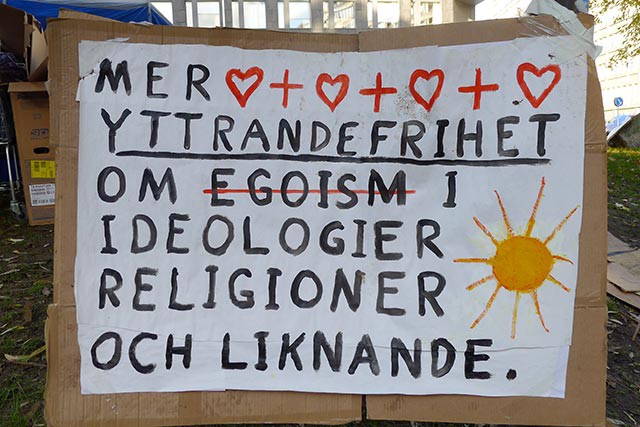
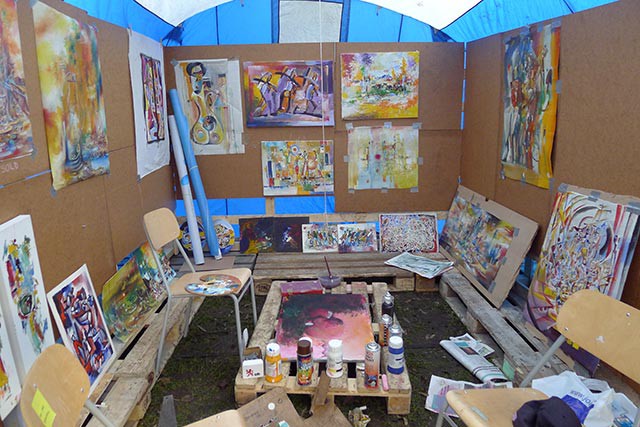
Near the food tent I met a young woman in a bright pink hoodie named Naima Clevenhag. She had wide, earnest eyes, and she ate applesauce as she spoke with me. She told me that she had recently quit her hotel-waitress job because the evening shifts interfered with her political meetings. She said that she and the rest of the occupiers had no plans to leave, and that even though the camp was technically illegal, they hadn’t been bothered by the police at all.
“We’re having a really good relationship with the police, so we can’t look violent, because no one is being violent to us,” she said. “In the US, the police are being violent to the occupants, and that’s why they look violent. But here it’s like, [the police] come here and talk to us, like ‘Are you cold? Do you need anything?’”
We talked about the things that bothered her most, which ranged from homelessness in Stockholm to deregulation brought about by the Glass-Steagall Act in the US. She said some of the other occupiers there were satisfied with the political and economic reality of Sweden, and were, instead, protesting American policies and offer support to Occupy Wall Street. Throughout my stay in Stockholm I had been consistently impressed and by people’s knowledge of the inner workings of the United States, not to mention their flawless English. It humbled me. Before my trip, my knowledge of Sweden was limited to what I could learn by reading Stieg Larsson novels and listening to Robyn, and the only Swedish words I knew were the names of IKEA coffee tables.
Toward the end of our conversation I asked Naima what she and the other protesters told people who asked why they were there. She said that she talks about broad problems with the global financial system as a whole. “But if we give examples, it’s mostly from the U.S.,” she added.
***
A week later I arrived in Helsinki, where the Occupy camp is set up on a wide lawn, strategically centered in a triangle formed by the Parliament building, the famous Kiasma modern art museum, and the Sanoma media office building — headquarters of Helsingin Sanomat, the largest daily newspaper in Scandinavia. But if for some reason I had had trouble finding the camp, I could have simply followed the trails of chalk hearts drawn on the sidewalks of the surrounding streets — hearts containing the words “Rakastan sinua” and “Kuuntele sydantasi” (which mean “I love you” and “Listen to your heart” in Finnish).
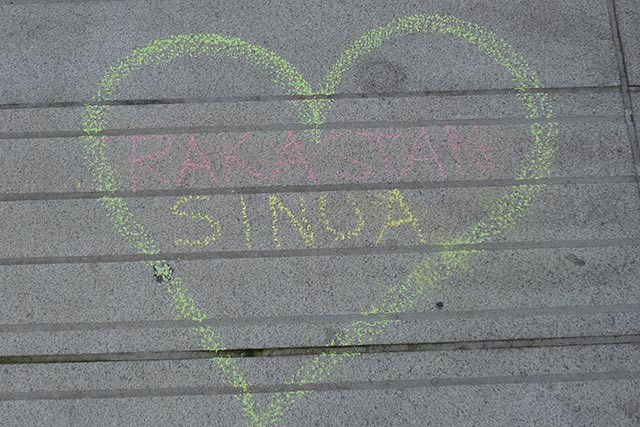
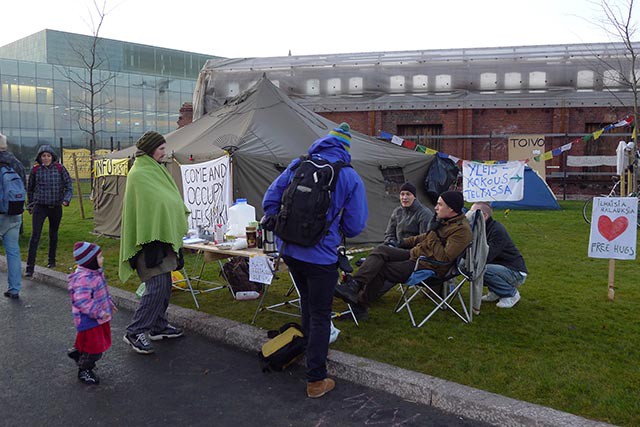
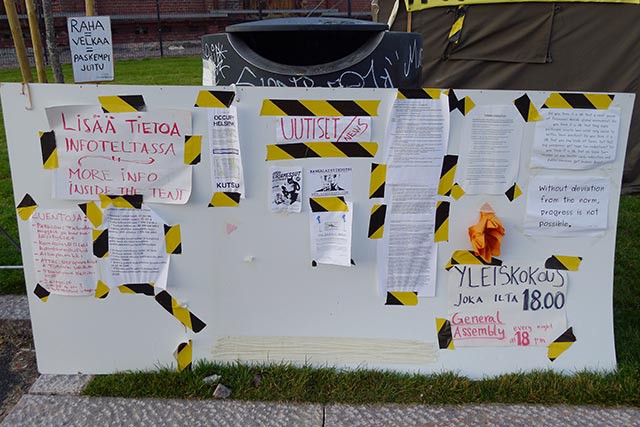
I said hello to a group of people sitting at an information table and told them I was visiting Finland from New York. I was immediately hugged and draped with a fleece blanket by a man in a purple hat named Yanne Kuoppamäki. Helsinki’s camp, like Stockholm’s, had military tents and a generator. It also had a stage for speech-making. Yanne said there were about eight to ten people staying overnight regularly, with about thirty or so joining in the evening meetings. In the meetings, he said, they talked mostly about economic policy, specifically the problems that come when taxpayers in the more prosperous countries in the EU are held fiscally responsible for the economies of countries like Greece. This was a particularly important issue in Helsinki, as Finland is the only Scandinavian country in the Eurozone.
Yanne acknowledged, though, that Finland also has its own problems. He told me that he himself was homeless and unemployed, and he had an eight-year-old daughter. Yanne wanted to see more low-income housing in Helsinki. And one thing that he most wanted to see improved was government support of nutritional food in school cafeterias, and natural health assistance for adults.
“It is a really challenging place to live, in Finland, because of the long winters,” he said, noting that the country has problems with alcoholism and suicide. During the coldest months, Helsinki’s daytime temperatures are around 25 degrees, and during the darkest months, the sun only shines for about six hours a day. “I think that the government should support, for example, Vitamin D treatment for people, that helps with winter depression.”
I asked if unemployment was a problem in Helsinki. “It is,” he said. “But we have pretty good social benefits here. Without them, it would be chaos here. This country would not make it.” (The latest figures show 7 percent unemployment for the country overall in October. The US had 9 percent in the same month.)
Yanne’s message to the protesters in New York was to be careful to keep their movement “peaceful and loving,” and also to be careful of how they were perceived, and careful that their collective name was not hijacked. “That’s one of my main themes here, is to keep this a peaceful and loving movement, so that it’s not directed in a negative way.” He was concerned that the Occupy Together website had a red and black color scheme, which are dark and aggressive-feeling colors. “They should be smart enough to choose the colors right, because it gives a strong message,” he said. He preferred the cooler and calmer violet for his signs and chalk-drawn hearts.
Like Naima, Yanne said the police hadn’t bothered the protesters at all. He said that an officer had come by once early on to say that they could stay camped on the lawn as long as the demonstration remained peaceful, and that they hadn’t seen him since. Later, after I had left Helsinki, the protesters posted a video on their website expressing solidarity with Wall Street to coincide with Occupy Together’s “International Day of Action” on November 17th. They marched to the U.S. embassy. (That’s Yanne in the middle, with the hat and the big sign on his chest, the sign that says “Stop the violence — Peace — Love.”)
https://www.youtube.com/watch?v=o3fDn-fgSNg
***
The next stop on my trip was Copenhagen, and I visited the city’s Occupy camp in the courtyard of the beautiful and stately City Hall. When I arrived in Denmark, the unemployment rate was 4.2 percent. The temperature was in the thirties, and Maja Vestergaard was literally shivering the entire time I talked to her. She said police had arrested her and a few other protesters one night for an illegal bonfire, but after a night in jail they came right back. (A video uploaded to YouTube in late October shows Danish police dismantling the first iteration of their camp.) Another occupier, named Amos Spenner, said he might leave temporarily to go back into the forest, where he and some other protesters were living high in trees to try to stop developers from cutting down wide swaths of the forest to make way for a wind farm.
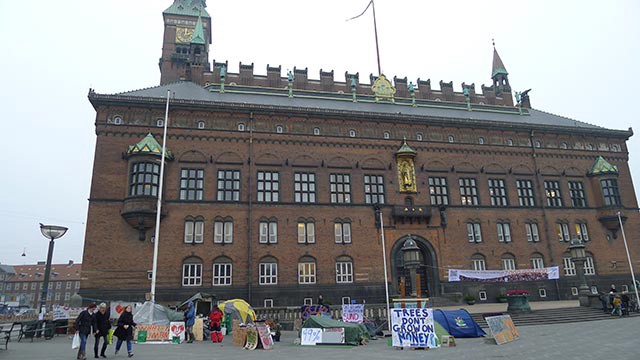
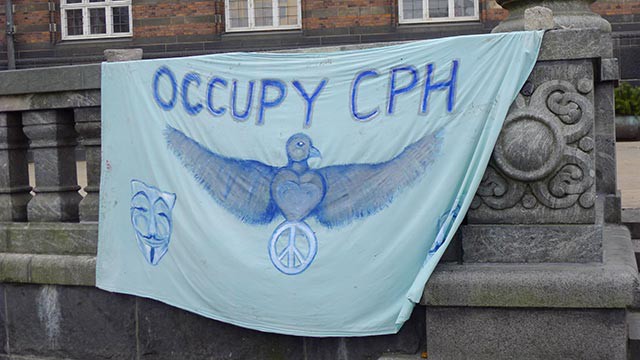
When I asked Maja and Amos what kinds of changes they’d like to see in Denmark, they explained how they thought direct democracy would be possible, if only the outdated government structure would allow it. By using Internet technology, they argued, it would be easy for everyone to vote online and collectively construct policy. They questioned the need for parliamentary representation. “People often say, ‘Yeah, but there’s no alternative, what’s your suggestion?’” said Maja. “There’s a lot of suggestions, but if you ask the politicians, of course they would not let them through, because then they would lose their power.”
I told them of the common conception in the US of the Scandinavian countries as prosperous and peaceful, socialist utopias without the extreme income disparity we have at home. Amos said he thought that the welfare state had the side effect of lulling Danes into complacency. “The people are falling asleep,” he said. “It’s so calm and quiet and nice that most people see it as some kind of movie, like we are in a Hollywood movie here…. Underneath, it’s very close to breaking out — there’s a hole in the balloon.”
After just a few minutes of talking to them I was shivering from the cold, too, and I guiltily speed-walked to a nearby bookstore to thaw my hands.
***
One city I visited that didn’t have a camp was Oslo. As of this year, it was the world’s second most expensive city after Tokyo, and I cursed under my breath every time I had to pay the equivalent of $22 for the cheapest sandwich on the menu. Hundreds of protesters took part in a rally there on October 15, but there wasn’t quite enough momentum to set up a permanent camp.
By contacting the Occupy Oslo Twitter account, I connected with a woman named Siri Klemetsaune. I asked her what the inspiration was for Oslo’s rally, and she wrote “Solidarity, solidarity, and solidarity.”
She added that she and her colleagues were impressed by how far the Occupy Wall Street movement had come in such a short amount of time. “That they were able to build and keep a settlement like that is amazing,” she wrote. “And with every setback they seem to grow stronger. Like when the power-generators were removed, they made eco-friendly bicycle generators.”
The best part of the Occupy Wall Street movement, Siri thought, was the way the occupiers wrote constant updates through social media and kept up communication with protesters around the world, so everyone could feel a part of what was happening back in New York. “They set precedence for every other OWS camp,” she wrote. “When other settlements are somewhat temporary and slightly unstable, it’s even more important that the NYC [camp] works as well as it does. It’s an inspiration for everyone.”
***
Just three days after Siri sent me that email, the NYPD forcibly cleared out the original camp at Zuccotti Park. Other camps in California, Oregon and Massachusetts were raided soon after. When protesters tried to move back into Zuccotti on New Year’s Day, 68 of them were arrested. Shortly after, now back home in Brooklyn, I wrote to everyone I had met in the Scandinavian Occupy camps, wishing them a Happy New Year and asking how things were going. I didn’t hear back from the Copenhagen crew, but I started to see reports online about rising tension between protesters, the Danish police and the general public. Several Jewish news sites and blogs have picked up on a story about one protester having apparently knocked down a large Menorah after a Hanukkah celebration in the public square; as the story goes, he was upset that their camp had been dismantled again for the occasion.
Despite this horrible publicity, among other setbacks, the Occupy Denmark movement continues to hold general meetings and plan events, in front of City Hall and elsewhere. Debate continues on the Occupy Denmark message boards, where one member recently described the movement as having become “smaller,” but “more harmonious” than it had been previously. The Occupy Denmark Facebook page shows a full schedule for January.
I heard back from Siri, who’s still holding down the Occupy Oslo Twitter feed. There’s still no physical camp in Oslo, but she said she feels there is a growing awareness of and sympathy for the movement among Norwegians. There’s a movement now to reexamine President Obama’s Nobel Peace Prize — Oslo protesters “have been promised a formal answer from the director of the Nobel committee,” she wrote, adding, “Though an actual revocation of the Nobel Prize is not likely to happen, it’s important to be able to have that discussion, which we did not have before.”
Siri said it was discouraging to watch the camp at Zuccotti Park get torn down, but that she was nevertheless impressed at how the original OWS crew is able to continue holding meetings and keep the movement going nevertheless. She also said, “These days, our main focus and encouragement is on Occupy Congress, January 17th, and I feel that united efforts of OWS are the strength carrying it all.”
The most surprising updates I got were from protesters in Finland and Sweden — surprising simply because they’re still out there. A vicious winter storm named Dagmar ripped across both countries on the day after Christmas, knocking down trees and power lines and shutting down trains for several days. In the past week, temperatures in Helsinki have dropped to the teens, and to the low twenties in Stockholm. The sun sets each day around 3:30 in the afternoon.
Yet an update from Yanne in Helsinki in December was upbeat — the police remained helpful and sympathetic, occupiers had gotten some positive attention from the local press, and visitors from other camps in Finland had been working with them on various projects and demonstrations. “Things are well at the Camp-Helsinki, we have some improvements,” he wrote, “for example we got a mobile sauna.” A post on the camp’s blog invited everyone in the area to an “Alternative Xmas Party” at the camp on Christmas Eve, where the protesters would provide rice porridge, gingerbread cookies, non-alcoholic mulled wine, and the sauna trailer. Guests were invited to bring a dish to share, “especially ham and rye bread.”
Yanne wrote again a few days ago, saying that the camp was still going strong in the new year, despite the challenge posed by the recent storms and the cold. “The winter has been rough,” Yanne writes in his latest note. “But Finns are used to harsh weather 🙂 we defeated the Russians and all you know :)”
The Occupy Stockholm camp, according to Naima, is still going, too. There are fewer people regularly sleeping there overnight — she says there are about five to ten of them now — but more people come to their regular meetings. It’s still illegal to camp outdoors in the city, and it’s illegal to build a bonfire in a public park, but Naima said the police don’t ever ask them to leave — they just come by to check on the campers and warm their hands by the fire. “Feels like we are the only occupiers in the world having it this easy,” Naima writes.
Of course, the weather hasn’t been easy on them. They had to rebuild a lot of the larger tents after Dagmar came through three weeks ago. “A lot of the campers did not sleep well for many nights,” she wrote. “And also all daytime was dedicated to building our tents stronger to be able to get through the next night.”
They’ve been camping out ever since the first big global protest on October 15. It’s been almost fourteen weeks — four and a half months. I asked Naima what was, to me, the obvious question. She answered: “Of course it is all still worth it! Even if it’s just one single person that changes his mind because of something we do, I feel it’s worth it.”
She talked about how protest tactics could adapt to changing situations — for instance, without the logistics of a physical camp to worry about, the Occupy movement in the U.S. could now focus on expanding their networks in different ways that aren’t dependent on one particular space. And the methods of spreading the message will be different in every city and in every point in time. I asked her what she and the other Stockholm protesters wanted to say to protesters here. She wrote: “I guess our message to New York City is that they should keep going.”
Related: The Struggle For The Occupy Wall Street Archives
Lauren Kirchner is a freelance journalist based in Brooklyn who has lately learned to love pickled herring.
